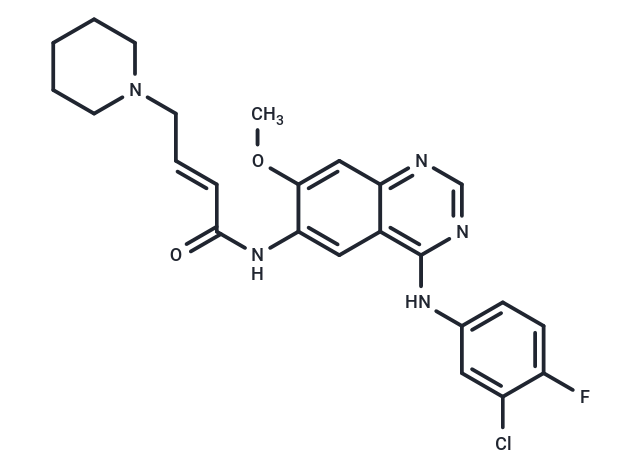Shopping Cart
- Remove All
 Your shopping cart is currently empty
Your shopping cart is currently empty

Dacomitinib (PF299)(PF299804; PF-00299804) is a highly selective, orally bioavailable small-molecule inhibitor of the HER family of tyrosine kinases with IC50 of 6, 45.7 and 73.7 nM for EGFR, ERBB2, and ERBB4, respectively.

| Pack Size | Price | Availability | Quantity |
|---|---|---|---|
| 1 mg | $32 | In Stock | |
| 2 mg | $45 | In Stock | |
| 5 mg | $72 | In Stock | |
| 10 mg | $129 | In Stock | |
| 25 mg | $183 | In Stock | |
| 50 mg | $239 | In Stock | |
| 100 mg | $372 | In Stock | |
| 200 mg | $468 | In Stock | |
| 500 mg | $769 | In Stock | |
| 1 mL x 10 mM (in DMSO) | $72 | In Stock |
| Description | Dacomitinib (PF299)(PF299804; PF-00299804) is a highly selective, orally bioavailable small-molecule inhibitor of the HER family of tyrosine kinases with IC50 of 6, 45.7 and 73.7 nM for EGFR, ERBB2, and ERBB4, respectively. |
| Targets&IC50 | EGFR:6.0 nM, ERB4:73.7 nM, ErbB2:45.7 nM |
| In vitro | PF-299804 (15 mg/kg, p.o.) exhibits strong antitumor activity, inducing significant tumor regression in various human cancer xenograft models. These include models expressing and/or overexpressing members of the ERBB family, or those harboring the double mutation (L858R/T790M) in ERBB1 (EGFR), associated with resistance to erlotinib and gefitinib. |
| In vivo | PF299804 inhibits EGFR signaling and induces apoptosis in the H3255 GR cell line containing the EGFR T790M mutation. It also suppresses the growth of H3255 and HCC827 cells expressing the T790M mutant. In HER2-amplified gastric cancer cells, PF299804 triggers apoptosis and G1-phase arrest, inhibiting the HER family and downstream signaling pathways, including the phosphorylation of receptors in STAT3, AKT, and extracellular signal-regulated kinase (ERK). It prevents the formation of EGFR/HER2, HER2/HER3, and HER3/HER4 heterodimeric complexes in SNU216 cells, as well as the binding of HER3 to p85α. PF299804 reduces phosphorylation levels of HER2, EGFR, HER4, AKT, and ERK in most sensitive cell lines. It exerts its anti-proliferative effect through G0/G1 phase arrest and induction of apoptosis. In a study of 47 human breast cancer and immortalized breast epithelial cell lines, PF299804 preferentially inhibited the growth of HER-2-amplified breast cancer cell lines compared to non-amplified lines (RR = 3.39, p < 0.0001). |
| Kinase Assay | ELISA-Based ERBB Kinase Assay: The ERBB1, ERBB 2, and ERBB4 cytoplasmic fusion proteins are made by cloning the ERBB1 sequence (Met-668 to Ala-1211), ERBB2 (Ile-675 to Val-1256), and ERBB4 sequence (Gly-259 to Gly-690) into the baculoviral vector pFastBac using PCR. Proteins are expressed in baculovirusinfected Sf9 insect cells as GST fusion proteins. The proteins are purified by affinity chromatography using glutathione sepharose beads. Inhibition of ERBB tyrosine kinase activity is assessed using an ELISA-based receptor tyrosine kinase assay. Kinase reactions (50 mM HEPES, pH 7.4, 125 mM NaCl, 10 mM MgCl2, 100 μM sodium orthovanadate, 2 mM dithiothreitol, 20 μM ATP, PF299804 or vehicle control, and 1-5 nM GST-erbB per 50 μL of reaction mixture) are run in 96-well plates coated with 0.25 mg/mL poly-Glu-Tyr. The reactions are incubated for 6 minutes at room temperature while being shaken. Kinase reactions are stopped by removal of the reaction mixture, and then the wells are washed with wash buffer (0.1% Tween 20 in PBS). Phosphorylated tyrosine residues are detected by adding 0.2 μg/mL antiphosphotyrosine antibody (Oncogene Ab-4; 50 μL/well) coupled to horseradish peroxidase (HRP) diluted in PBS containing 3% BSA and 0.05% Tween 20 for 25 minutes while being shaken at room temperature. The antibody is removed, and plates are washed in wash buffer. HRP substrate (SureBlue3,3?,5,5?-tetramethyl benzidine or TMB) is added (50 μL per well) and incubated for 10-20 minutes while it is shaken at room temperature. The TMB reaction is stopped with the addition of 50 μL of stop solution (0.09 N H2SO4). The signal is quantified by measuring absorbance at 450 nm. IC50 values are determined for PF299804 using the median effect method. |
| Cell Research | Growth and inhibition of growth is assessed by 5-(3-carboxymethoxyphenyl)-2-(4-sulfophenyl)-2H-tetrazolium (MTS) assay. This assay, a colorimetric method fordetermining the number of viable cells, is based on the bioreduction of MTS by cells to a formazan product that is soluble in cell culture medium, can be detected spectrophotometrically. The cells are exposed totreatment for 72 hours, and the number of cells used per experiment is determined empirically. All experimental points are set up in 6 to 12 wells, and all experiments are repeated at least thrice. The data are graphically displayed using GraphPad Prism version 3.00 for Windows (GraphPad Software). The curves are fitted using a nonlinear regression model with a sigmoidal dose response.(Only for Reference) |
| Alias | PF-299804, PF299, PF-00299804 |
| Molecular Weight | 469.94 |
| Formula | C24H25ClFN5O2 |
| Cas No. | 1110813-31-4 |
| Smiles | COc1cc2ncnc(Nc3ccc(F)c(Cl)c3)c2cc1NC(=O)\C=C\CN1CCCCC1 |
| Relative Density. | 1.344 g/cm3 |
| Storage | Powder: -20°C for 3 years | In solvent: -80°C for 1 year | Shipping with blue ice. | ||||||||||||||||||||||||||||||
| Solubility Information | DMSO: 45 mg/mL (95.76 mM), Sonication is recommended. | ||||||||||||||||||||||||||||||
Solution Preparation Table | |||||||||||||||||||||||||||||||
DMSO
| |||||||||||||||||||||||||||||||

Copyright © 2015-2025 TargetMol Chemicals Inc. All Rights Reserved.